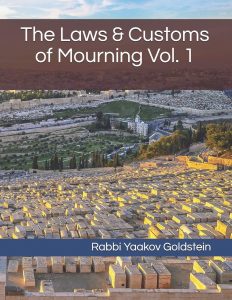6. When to start Shiva if the body cannot be buried:[1]
If one is unable to bury the body, then as soon as the person gives up hope in burying the body, Shiva is begun. This applies at all times, whether within thirty days of death or later.[2] Thus, if the body went missing, such as it became lost at sea, or in the jungle, then the moment the relatives give up hope of retrieving the body, they begin counting Shiva and Shloshim.[3] [If, however, the missing person was married, then the relatives do not begin Shiva/Shloshim, until enough proof of death has been provided to the point that his wife may remarry.[4] See Chapter 12 Halacha 12!]
Temporarily giving up hope: Even if one hopes to eventually bury the corpse if the circumstances allow it to be done, if he has given up hope for the body to be buried under the current circumstances, and has thus sealed it in its coffin on wait, then Shiva is to be started right away.[5] For example, if the body was placed in the coffin and a military siege [and possible conquest of the city[6]] is preventing burials from taking place, then the relatives begin sitting Shiva and counting Shloshim from the moment that the coffin is sealed with nails.[7] [If, however, one has not yet sealed the body in its coffin, then although he has temporarily given up hope in burying the body, he does not begin Shiva until he gives up hope entirely.]
War captive:[8] If the body has been captured in war and is not being released by the enemy, then as soon as one gives up hope of a diplomatic solution to receiving the body, one begins to count Shiva and Shloshim. This applies even if military options are available, and have not been ruled out.[9]
Body brought to burial after Shiva:[10] In the event that one gave up hope of burial, and thus sat Shiva, and the body was then found and brought to burial after Shiva, the mourning does not restart. However, the sons [and other relatives[11]] must practice Shiva on the day of the burial [even if they are not present by the burial, but were informed of it[12]], similar to what is done with Likut Atzamos. If they did not discover the burial until the next day, then they do not need to mourn at all.
| When does Shiva begin if the body was burnt to ash r”l?[13] One begins Shiva as soon as he is notified of the tragedy, as there is no Mitzvah to bury the ash of the deceased. [However, some Poskim[14] rule that if a person’s relative was intentionally cremated, then one does not mourn over his passing, and there is no Aninus, Shiva, Kaddish, or Yahrzeit held in his memory. Practically, a Rav is to be contacted in such a case.]
|
____________________________________________________________________________
[1] Michaber 345:7; 375:4-7
[2] Shach 375:6
[3] Michaber 375:7
[4] Shach 375:7 and Taz 375:3 in implication of Michaber ibid who writes “Mayim Sheyeish Lahem Sof”; Rama E.H. 17:5; Beis Yosef 375 in name of Ittur in name of Teshuvos Harif
Other opinions: Some Poskim rule that so long as the word of his death has spread, and the relatives give up hope of finding the body, they begin Shiva even though the wife may not yet Halachically remarry. [Rav Haiy and Sherira Gaon, brought in Tur 375, Shach ibid]
[5] See Michaber 375:4; Rosh Moed Katan 56; Mordechai 900; Shach 375:5; Beis Yosef 375; Bach 375; See next sentence and footnotes there
Other opinions: Some Poskim rule that in truth according to Rabbeinu Tam [brought in Halacha 1] we never begin Shiva and Shloshim until the earth burial is complete unless one gives up hope of burial, and this is not considered like giving up hope. Rather, the reason why in the case of Rebbe Klunemous they ruled to begin Shiva right away is because they in truth hold like Rashi that the closing of the casket signifies the start of Aveilus. [See Bach 375 in length for how he uses this to answer the seeming contradiction in the Michaber; The Shach ibid negates this explanation]
[6] See Shach ibid
[7] Michaber 375:4 “Although they plan to bury him in the cemetery after the siege is lifted, the closing of the casket is considered like burial in this regard”; Based on story that happened with Rebbe Klunemous Hazakein, brought in Rosh Moed Katan 56, Mordechai 900, Beis Yosef 375:4; Shach 375:5; See however Bach ibid brought in previous footnote
The reason: As once he seals the coffin, it is considered as if he gave up hope of burial, even if he desires to bury the corpse afterwards, as one has no idea if this will become possible, and it is hence as if the coffin is his place of burial. [Shach 375:5, unlike explanation of Bach ibid]
[8] See Michaber 375:5 regarding Harugei Malchus, and the same would apply here
[9] The reason: As it is not common to perform a military operation simply to retrieve a body, and it is likewise filled with danger and possible sin. [See Beis Yosef 375:5; Beis Hillel 375:5]
[10] Michaber 375:7; Taz 375:2 in name of Rebbe Yaakov and Ramban based on story that happened that a Jew’s murdered body was thrown and lost in a river on the 10th of Teves and his son gave up hope before Adar, and the body was then discovered after the Shiva and buried.
[11] See Shach 375:8-9 as rules Michaber 403:1 and 5 regarding Likut Atzamos that all mourning relatives must mourn and not just the sons
[12] Shach 375:9
[13] Chelkas Yaakov 1:32; Gesher Hachaim 16:8-5; Pnei Baruch 8:4
[14] Darkei Chesed 10:6; Nitei Gavriel ibid


Leave A Comment?
You must be logged in to post a comment.